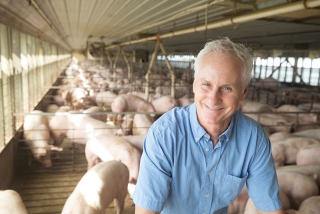
Leaner Pigs Mean Opportunities for Health-conscious Chefs
31 May 2019Innovations in care, housing, feeding and health protocols of pig raising have led to big changes in how chefs prepare pork.
By Thomas Smith
 If you cook pork, you will be glad to know the meat is leaner today than ever before. Improvements in pork quality stem from advancements in science and technology, which pig farmers have implemented across the country. Not only do farming innovations produce better meat, they also ensure a higher quality of life for the pigs.
If you cook pork, you will be glad to know the meat is leaner today than ever before. Improvements in pork quality stem from advancements in science and technology, which pig farmers have implemented across the country. Not only do farming innovations produce better meat, they also ensure a higher quality of life for the pigs.
In Arrowsmith, Ill., Patrick Bane operates and co-owns a pig farm alongside his two brothers. Most growers in central Illinois produce grains in the exceedingly fertile soil, but raising piglets is a proud tradition for the Bane family. The third-generation grower and 2018 recipient of the National Pork Board Pig Farmer of the Year said his state-of-the-art technology and first-rate business practices keep his farm at the top of the industry.
The family’s land spans 50 acres, but only about five acres are dedicated to raising pigs. His farm births and raises about 70,000 piglets each year. The pork industry is divided into either farms that take a piglet and grow them for market or farms that birth and raise piglets. Bane breeds piglets and sends the three-week-old animals to another operation to continue growing. Bane said it is important to maintain a close relationship with the people who raise his hogs into adulthood.
 “We’re very conscious that we’re not just raising pigs,” Bane said, “but that we’re raising food. I think we’re doing it not just for us, but for the community and for all pork producers.”
“We’re very conscious that we’re not just raising pigs,” Bane said, “but that we’re raising food. I think we’re doing it not just for us, but for the community and for all pork producers.”
Today, many pork cuts are just as lean or leaner than chicken and meet the government’s extra lean standards. Pigs were once prized for their fat, but this shifted when culinarians in the United States began moving away from using lard for shortening. While swine once had about two inches of back fat, they now have been bred to have less than half an inch. Bane said this fat has been converted to muscle with marbling, which is good for consumers because it means pork is more tender and has less gristle.
The best pork can be recognized by its red color and unique, versatile flavor. “It’s important that the color is right,” the farmer said, “because the color is moisture capacity. You want it to be red and not pale, because red means moisture, and moisture means tenderness and juiciness.”
In 2011, the U.S. Department of Agriculture changed the recommended internal cooking temperature for pork from 160 F to 145 F, which results in a pinker color than veteran chefs were accustomed. This allows for pork to be consumed medium rare, although ground pork should still be cooked at 160 F. Bane said that the reduction in temperature resulted from growers eradicating the infection-causing trichinosis parasite.
“It’s ok (to cook pork to 145 F) because of the care of the animals, the housing of the animals, the feeding of the animals, and the health protocol of the animals,” the farmer said. “That’s why it’s ok, and that’s a tribute to the way we raise the pigs today.”
Biosecurity is important for pig farmers. The grower said anyone who visits another area where hogs are raised must wait 48 hours before entering his farm to ensure no diseases are spread. The Bane farm also promotes biosecurity by raising their own mothers from piglets, who are selected based on genome testing, motherly traits, and the performance of sow relatives. This stops the spread of disease from swine raised elsewhere.
Responsible management of manure is also critical. While many pig farmers hire others to dispose of manure, the grower personally oversees the utilization of manure from his farm. Bane said he applies his manure to hundreds of acres of neighboring farmland, helping to grow crops that will eventually feed pigs. In fact, many farmers add swine to their business so they can take advantage of the nitrogen, potassium, phosphates and micronutrients found in manure.
Numerous technological advancements contribute to ensuring the pigs’ well-being, but temperature controls are most significant to a hog’s happiness. Because pigs lack the ability to regulate their own temperature, they rely on heating and air conditioning to remain content. Bane said swine, like humans, perform better when they are comfortable, and this is especially true in the case of pregnant pigs.
“In my opinion, the pigs are cared for better today than they ever have been,” the farmer said, “and I can say that because I’ve been raising pigs all my life.”
